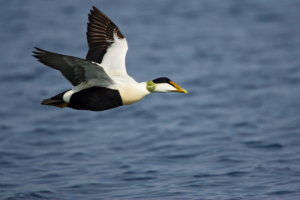
The Icelandic eiderdown holds a significant volume of air, thus making it very light with great insulation. Eiderdown has small, unique, hook-like threads that lock it together, providing the insulation’s air pockets.
Less amount of eiderdown than diamonds in the world is hand collected from Icelandic nature every year. Eiderdown is, 100% natural and rare luxury, ethically sourced by eider farmers who take care of the wild eider ducks visiting their grounds year after year.
The Icelandic Eider duck (Somateria Mollissima) is a local species that lives along the country’s coast. During wintertime the Eider ducks live at the sea where they have the tasty and nutritious seafood to eat. In the spring they return to the land to lay eggs. In the cold Icelandic winters, the Eiders needs to be protected against the cold climate. The ultimately warm and soft eiderdown on her breast keeps her warm while she lives at the sea gaining weight to prepare her body for the nesting season.


The Icelandic Eider duck (Somateria Mollissima) is a local species that lives along the country’s coast. During wintertime the Eider ducks live at the sea where they have the tasty and nutritious seafood to eat. In the spring they return to the land to lay eggs. In the cold Icelandic winters, the Eiders needs to be protected against the cold climate. The ultimately warm and soft eiderdown on her breast keeps her warm while she lives at the sea gaining weight to prepare her body for the nesting season.
With the ultimately warm eiderdown on her chest, she is not able to expose her body heat to the eggs, therefore the female Eider sheds the eiderdown. This exposes her body warmth to the eggs. During nesting time, the Eider ducks prefer to live and raise their ducklings near the people who take care of them. When it is safe for the Eiders, farmers carefully collect the eiderdown.


The history of eiderdown harvesting is closely linked to Iceland’s history. Since the country was settled in the 9th century the Eider ducks have lived in perfect harmony with Icelanders. A unique relationship has developed between farmers and eiders. They trust each other. The Eider ducks are fully protected species in Iceland and have been since 1847. The use of eiderdown and the culture of eider farming are rich with Icelandic tradition. Only around 4000 kg of eiderdown is collected worldwide every year, from Iceland the amount is about 3000 kg of the total quantity.
Icelandic eiderdown is ethically sourced and sustainable options as well as it is biodegradable and renewable.

The Icelandic eiderdown holds a significant volume of air, thus making it very light with great insulation. Eiderdown has small, unique, hook-like threads that lock it together, providing the insulation’s air pockets.
Less amount of eiderdown than diamonds in the world is hand collected from Icelandic nature every year. Eiderdown is, 100% natural and rare luxury, ethically sourced by eider farmers who take care of the wild eider ducks visiting their grounds year after year.

The Icelandic Eider duck (Somateria Mollissima) is a local species that lives along the country’s coast. During wintertime the Eider ducks live at the sea where they have the tasty and nutritious seafood to eat. In the spring they return to the land to lay eggs. In the cold Icelandic winters, the Eiders needs to be protected against the cold climate. The ultimately warm and soft eiderdown on her breast keeps her warm while she lives at the sea gaining weight to prepare her body for the nesting season.

The Icelandic Eider duck (Somateria Mollissima) is a local species that lives along the country’s coast. During wintertime the Eider ducks live at the sea where they have the tasty and nutritious seafood to eat. In the spring they return to the land to lay eggs. In the cold Icelandic winters, the Eiders needs to be protected against the cold climate. The ultimately warm and soft eiderdown on her breast keeps her warm while she lives at the sea gaining weight to prepare her body for the nesting season.

With the ultimately warm eiderdown on her chest, she is not able to expose her body heat to the eggs, therefore the female Eider sheds the eiderdown. This exposes her body warmth to the eggs. During nesting time, the Eider ducks prefer to live and raise their ducklings near the people who take care of them. When it is safe for the Eiders, farmers carefully collect the eiderdown.

The history of eiderdown harvesting is closely linked to Iceland’s history. Since the country was settled in the 9th century the Eider ducks have lived in perfect harmony with Icelanders. A unique relationship has developed between farmers and eiders. They trust each other. The Eider ducks are fully protected species in Iceland and have been since 1847. The use of eiderdown and the culture of eider farming are rich with Icelandic tradition. Only around 4000 kg of eiderdown is collected worldwide every year, from Iceland the amount is about 3000 kg of the total quantity.
Icelandic eiderdown is ethically sourced and sustainable options as well as it is biodegradable and renewable.


